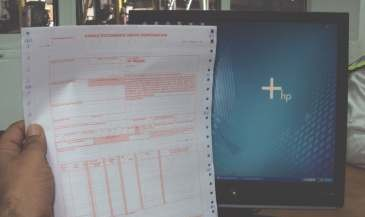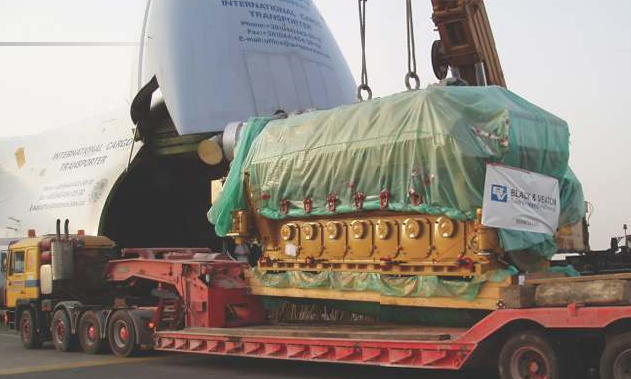e-Air Waybill - Sympifying the air cargo business
Twenty years ago, Air Cargo Update took a bold step to enter this niche industry publication. It was a remarkable journey of ups and downs as air cargo and its supply chain swung back and forth to the demands of the day punctuated by today’s unforeseen impact of the Coronavirus pandemic.
To mark our historic journey, we’ll bring you some of our best features from the past two decades, the movers and shakers with their insights and decisions that helped shape today’s air cargo industry.
More than a decade ago, IATA advocated for the gradual digitalization of the industry starting with the use of e-AWB.
In this edition, let’s look back at Shashi Panicker, Head of Cargo at Sharjah Aviation Services, as he discussed with ACU in 2012 the many benefits of the e-AWB and e- freight and why so many companies are struggling to adopt to the changes.
With e-Air Waybill (e-AWB) and e-freight deadlines looming over the air cargo industry, Air Cargo Update takes a look at the e-AWB and the status of its implementation across the globe and in the Middle East in particular. Shashi Panicker, Head of Cargo at Sharjah Aviation Services shared with us his views on the subject
In an effort to change the way aviation industry operates and improve the aviation and air cargo standards globally, the International Air Transport Association (IATA) has been advocating changes on various fronts through its simplifying the business programme. IATA is currently working within Global Air Cargo Advisory Group (GACAG) on e-commerce, security, customs and trade facilitation and sustainability.
The organisation is facilitating these collective cargo industry initiatives with the ultimate goal of bringing in sustainability to the sector.
In the current environment, the transportation of air cargo still involves a whole lot of paper documents. Therefore, IATA is focusing on the need for the air cargo sector to tackle e-freight; and rather than asking the industry to do all at once, the body has set deadlines to first achieve 100% implementation of e-AWB in a phased manner. The air waybill (AWB) is a key document in air cargo transport and an e-AWB is a first step towards creating a paperless environment.
Developed in collaboration with industry stakeholders, the e-AWB removes the requirement for paper AWB, which
significantly simplifies the air freight supply chain process.
The benefits of doing away with the large number of paper documents required for air cargo shipments as identified by industry stakeholders are: reduced paper use and need to print, handle and archive paper AWBs; simplified data entry and maintenance; reduced transfer times; and real-time access to bill date for all personnel. All these add up to bring about overall efficiency in the operations, and in the long term, result in significant cost savings for the air cargo and logistics sectors. In fact, IATA has estimated that this could translate into about US$4.9 billion of industry saving.
The challenge has been that countries worldwide have been slow in implementing e-commerce solutions. In the Middle
East, the implementation of e-freight and e-AWB has been much slower than anticipated. There is a need for various
stakeholders in the industry to come together to device a smart mechanism wherein a successful model can be drawn
up for the speedy implementation of the e-AWB.
Shashi Panicker, Head of Cargo at Sharjah Aviation Services enumerated the reasons for the slow rate of implementation of the e-AWB in the region.
In his view, the air cargo industry is relying heavily on paper documentation even today for a few reasons:
• The implementation of e-AWB and e-freight requires major investment in terms of time, technology and money
• Secondly the stakeholders are to agree the industry benefits and come forward with the required changes and investments, the world wants to comply.
On the benefits of e-AWBs, the Cargo Head said there were many benefits including reduced costs; higher productivity; better reliability; regulatory compliance; reduced cargo handling delays; paving the way towards e-freight; realtime access to AWB information; and elimination of the requirements to file paper AWB. When asked as to whether e-freight could be seen as a total solution, Panicker said, “e-freight can be a solution as it aims to take paper documents out of air cargo and replace it with the exchange of electronic data and messages that would lead to the following benefits: lower costs, faster supply chain transit times, greater accuracy, regulatory compliance, increased security, and it is better for the environment.”
“But, e-freight cannot replace paper documentation totally. Only 20 paper documents can be replaced with electronic
messages. The remaining documents are not in scope of e-freight, as they are not currently supported by international standards,” he continued.
With specific reference to Sharjah Aviation Services as well as the cargo carriers operating from Sharjah Airport, Panicker said they had not yet fully adopted the e-AWB, which are through FWB and FHL. “Implementation of the e-AWB is not an easy process and requires a whole system change which calls for investment, tremendous effort and coordination among various authorities and other stakeholders who are involved in the air cargo supply chain, to which we remain committed.”
In Panicker’s opinion, the major challenges in switching over to e-AWB in the Middle East are: (a) The ability of their customers to electronically transmit FWB and FHL through their system which are SITA enabled on SHJFFXH (b) The governing bodies to accept paperless transaction as the means of approval (b) System change, which requires the implementation of standardised electronic data interchange.
 The stakeholders involved in the air cargo supply chain are Shippers, Airlines, Forwarders and Ground Handlers. The airlines, he said, “have to take the lead to implement e-AWB with the forwarders; and forwarders should support airlines for e-AWB rollout by means of FWB and FHL messages to the handling company. To this end they have to trust EDI Agreement from the airline; own the responsibility to send FWB and FHL data; and cutover according to airline set target date.”
The stakeholders involved in the air cargo supply chain are Shippers, Airlines, Forwarders and Ground Handlers. The airlines, he said, “have to take the lead to implement e-AWB with the forwarders; and forwarders should support airlines for e-AWB rollout by means of FWB and FHL messages to the handling company. To this end they have to trust EDI Agreement from the airline; own the responsibility to send FWB and FHL data; and cutover according to airline set target date.”
“This of course improves the ground time while serving the customer,” said Bradley Boyd, Senior Cargo Operations
Manager, Sharjah Aviation Services, who believes is ground breaking for a traditional process which is long followed by the industry.
The Cargo Head stressed that it was important that the stakeholders cooperate and agree on the implementation
of the e-AWB. And how can they achieve that? “First the airlines, shippers and ground handlers should have a clear
understanding of the benefits in implementing e-AWB bills. Only then, all the stakeholders will have the same goal to effectively implement the e-AWB.”
 IATA has set the targets for airlines and freight forwarders with regard to e-AWB, with the aim of achieving 15% e-AWB implementation by 2012, 70% by 2013 and 100% by 2014.
IATA has set the targets for airlines and freight forwarders with regard to e-AWB, with the aim of achieving 15% e-AWB implementation by 2012, 70% by 2013 and 100% by 2014.
Did Panicker think this could be achieved in the Middle East or in the UAE within the set time frame? “Yes. As the leading airlines like Emirates SkyCargo have already taken the initiative in implementing e-AWB, it is not impossible for other airlines/ forwarders and ground handlers in the UAE to follow suit and achieve the full implementation of e-AWB,” he commented.
Positive developments
On the positive side, significant strides have been made by key players in some countries with regard to e-freight, which could induce more players to follow suit, going by the success rate of implementation of these initiatives by some key stakeholders.
Cathay Pacific Airways was one of the first airlines to switch to 100% e-AWB in Hong Kong, having removed paper AWBs totally from its Hong Kong International Airport hub in January 2011. Cathay Pacific introduced e-AWBs in Singapore and Malaysia in the first quarter of 2012.
Likewise, Hong Kong Air Cargo Terminals Ltd (Hactl) has also made a great deal of progress in e-freight initiatives, having completed the final phase of implementation of its fully e-freight-enabled COSAC-Plus cargo management system in April this year. All the 91 airline customers handled by Hactl have transferred smoothly onto the new system.
In the Middle East, Emirates SkyCargo has taken the lead role in spearheading the e-freight agenda regionally and
globally. In addition to eliminating paper air waybills in Dubai with the use of e-AWBs on all shipments out of its hub, the cargo carrier marked a milestone with its inaugural 100% paperless freighter flight between Nairobi and Amsterdam in April 2011. This indicates a significant step towards working in a completely electronic environment that will enhance operational efficiency to the supply chain. It is notable that 51 of the 111 cities Emirates SkyCargo serves are e-freight compliant.
In fact, the Dubai Customs have been very proactive in this area and are keen on electronic clearances. Within the Emirates Group there are several companies that have similar objectives. The ground handling agency dnata is doing a lot in this on the ground. Calogi, launched in Dubai mid-2008 to facilitate a comprehensive and integrated business environment for the air cargo supply chain community, has been one of the most successful trading platforms. Through this cost-effective portal designed for small-to-medium enterprises, freight forwarders can effectively do business with trading partners such as the cargo terminals, airlines and 3PLs.
Calogi allows people to trade in a seamless environment and has made Dubai (DXB) and Al Maktoum airports (DWC)
easier places to do business with.
There are several elements involved in the cargo transportation process where paper is required, and achieving 100 per cent e-freight is being dictated by various governmental clearance processes, with most of them still requiring a lot of paperwork.
Again, considering that many stakeholders and countries are involved in the supply chain and the border control
processes that come into play, one of the key requirements is the ratification of the Conventions. Unless the countries involved are in line with the agreements, it would be difficult for the stakeholders to go digital. If one country is on MP4 and the other has ratified MC99, it reverts back to 1928 Warsaw Convention which is a paper-based transaction and therefore a barrier to e-AWB. So the ratification of all these conventions is important for all cargo players.
The air cargo sector in the UAE is fortunate in that the country has ratified both MP4 and MC99. So they can transact with both parties, which is an advantage.
IATA is working with airlines, the national carriers and governments in an effort to achieve the set targets on time. Going by the current developments, in addition to many other global initiatives with regard to e-freight and e-AWBs, IATA’s vision of achieving 100% e-AWB for the complete cycle of the shipment on feasible lanes by end 2014 may well be realised.
Note: Air Cargo Update will be following closely the developments in the Middle East with regard to e-AWB and
e-freight to provide regular updates to our readers.











